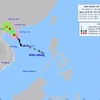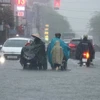An extreme weather pattern is striking the south-central, Central Highlands and southern regions due to the transition from the dry season to the rainy one, The Saigon Times Daily has reported.
The paper quoted meteorologist Le Thi Xuan Lan as saying that after a dry season lasting around five months, the transitional period from the dry season to the rainy season often falls on early April.
On the Vernal Equinox Day on March 21, the move of the sun from the southern hemisphere to the northern hemisphere caused radiant energy for the northern hemisphere to increase vigorously.
Due to their locations near the low latitude area, the south-central, Central Highlands and southern regions have suffered a strong rise in radiant energy supply. Hot weather on the mainland, in combination with rising humidity in the sea and easterly winds, has made the evaporation volume surge sharply, resulting in dense thunderclouds at a height of 6-8 kilometers. Those thunderclouds can lead to dangerous weather patterns such as hail, tornado and lightning.
Therefore, hails often happen in season transitional rains in south-central provinces while mountainous provinces like the Central Highlands and the northern part of the southern region including Tay Ninh, Dong Nai and Binh Phuoc provinces are prone to lightning.
Meanwhile, Ho Chi Minh City and other southern provinces this week have seen season transitional rain, which is expected to continue after a few scorching days. The shorter interval between rains, the greater the danger.
Lan advised locals to be watchful when seeking shelter from rain as old trees could be easily struck down by rainstorms or tornados. She asked people to keep their children from playing in the rain to avoid possible thunder strikes.
On April 7, a tornado along with hail struck three hamlets in Son Linh commune in the mountainous district of Son Ha in the central province of Quang Ngai, unroofing hundreds of local homes. On the same day, a resident was reportedly killed by a lightning strike in Duc Trong district in the Central Highlands province of Lam Dong.
Drought seen more severe in southern region
In a related development, the Ministry of Agriculture and Rural Development has reported lower rainfalls in many areas such as Ninh Thuan and Binh Thuan provinces and the Central Highlands, accounting for 50-90% of the average levels in previous years. The agricultural sector would face severe water shortages in the near future.
According to reports by the agriculture departments of the affected provinces, water levels at reservoirs in southern provinces are at 60-70% capacity while the percentages in some localities such as Ninh Thuan and Binh Thuan are 25-40% and 40-60% in the Central Highlands and the southeastern region.
Similarly, water levels at the Tra Khuc River in Quang Ngai province, the Cai River in Nha Trang city and the La Nga River in Binh Thuan province are very low while seawater has made its way deep into Vu Gia and Thu Bon rivers in the central region.
If hot weather continues, rice farming areas will be heavily affected. Over the past few months, the dried-up coffee farming areas in Di Linh and Da Huoai districts in Lam Dong province have been rising due to little rain.
The crop areas affected by a water undersupply in Binh Phuoc amount to 14,000 hectares and nearly 5,500 hectares in Ninh Thuan and 5,450 hectares in Daklak.
According to the Southern Institute of Water Resources Research, the highest level of salinity at the Cau Noi station on the Vam Co River is recorded at 18-21 grams per liter this month while there was no fresh water in this area from February to May. At the Cuu Dai River, salinity was measured at 24-26 g per liter.
The central meteorology forecast centre says hot weather will continue in central provinces, the Central Highlands, southeastern provinces and the Mekong Delta in the near future as the rainy season may arrive later than in previous years.-VNA
The paper quoted meteorologist Le Thi Xuan Lan as saying that after a dry season lasting around five months, the transitional period from the dry season to the rainy season often falls on early April.
On the Vernal Equinox Day on March 21, the move of the sun from the southern hemisphere to the northern hemisphere caused radiant energy for the northern hemisphere to increase vigorously.
Due to their locations near the low latitude area, the south-central, Central Highlands and southern regions have suffered a strong rise in radiant energy supply. Hot weather on the mainland, in combination with rising humidity in the sea and easterly winds, has made the evaporation volume surge sharply, resulting in dense thunderclouds at a height of 6-8 kilometers. Those thunderclouds can lead to dangerous weather patterns such as hail, tornado and lightning.
Therefore, hails often happen in season transitional rains in south-central provinces while mountainous provinces like the Central Highlands and the northern part of the southern region including Tay Ninh, Dong Nai and Binh Phuoc provinces are prone to lightning.
Meanwhile, Ho Chi Minh City and other southern provinces this week have seen season transitional rain, which is expected to continue after a few scorching days. The shorter interval between rains, the greater the danger.
Lan advised locals to be watchful when seeking shelter from rain as old trees could be easily struck down by rainstorms or tornados. She asked people to keep their children from playing in the rain to avoid possible thunder strikes.
On April 7, a tornado along with hail struck three hamlets in Son Linh commune in the mountainous district of Son Ha in the central province of Quang Ngai, unroofing hundreds of local homes. On the same day, a resident was reportedly killed by a lightning strike in Duc Trong district in the Central Highlands province of Lam Dong.
Drought seen more severe in southern region
In a related development, the Ministry of Agriculture and Rural Development has reported lower rainfalls in many areas such as Ninh Thuan and Binh Thuan provinces and the Central Highlands, accounting for 50-90% of the average levels in previous years. The agricultural sector would face severe water shortages in the near future.
According to reports by the agriculture departments of the affected provinces, water levels at reservoirs in southern provinces are at 60-70% capacity while the percentages in some localities such as Ninh Thuan and Binh Thuan are 25-40% and 40-60% in the Central Highlands and the southeastern region.
Similarly, water levels at the Tra Khuc River in Quang Ngai province, the Cai River in Nha Trang city and the La Nga River in Binh Thuan province are very low while seawater has made its way deep into Vu Gia and Thu Bon rivers in the central region.
If hot weather continues, rice farming areas will be heavily affected. Over the past few months, the dried-up coffee farming areas in Di Linh and Da Huoai districts in Lam Dong province have been rising due to little rain.
The crop areas affected by a water undersupply in Binh Phuoc amount to 14,000 hectares and nearly 5,500 hectares in Ninh Thuan and 5,450 hectares in Daklak.
According to the Southern Institute of Water Resources Research, the highest level of salinity at the Cau Noi station on the Vam Co River is recorded at 18-21 grams per liter this month while there was no fresh water in this area from February to May. At the Cuu Dai River, salinity was measured at 24-26 g per liter.
The central meteorology forecast centre says hot weather will continue in central provinces, the Central Highlands, southeastern provinces and the Mekong Delta in the near future as the rainy season may arrive later than in previous years.-VNA



















